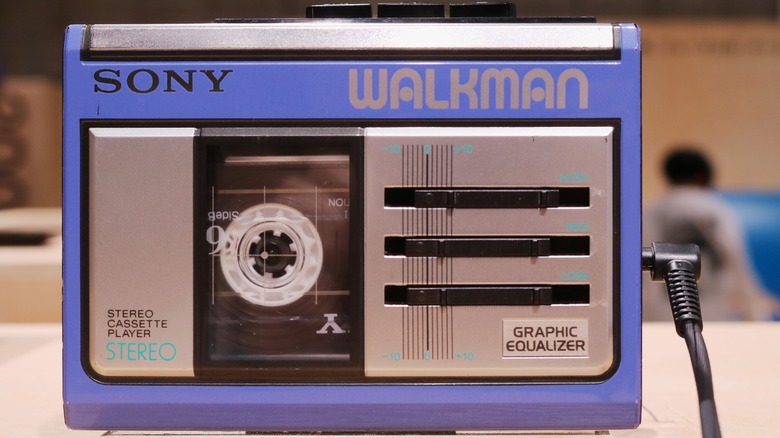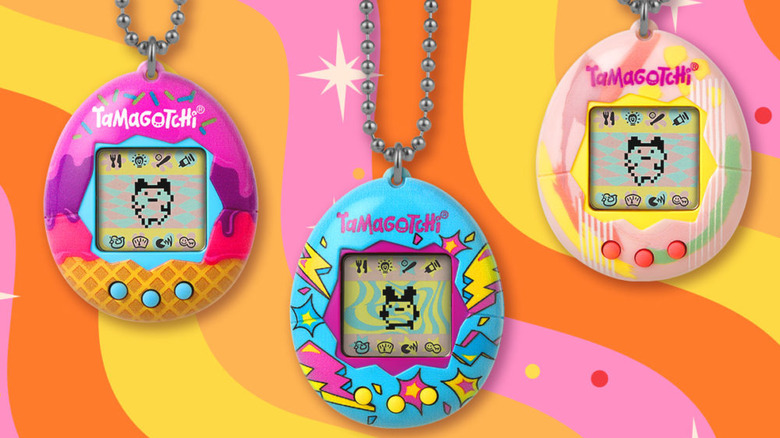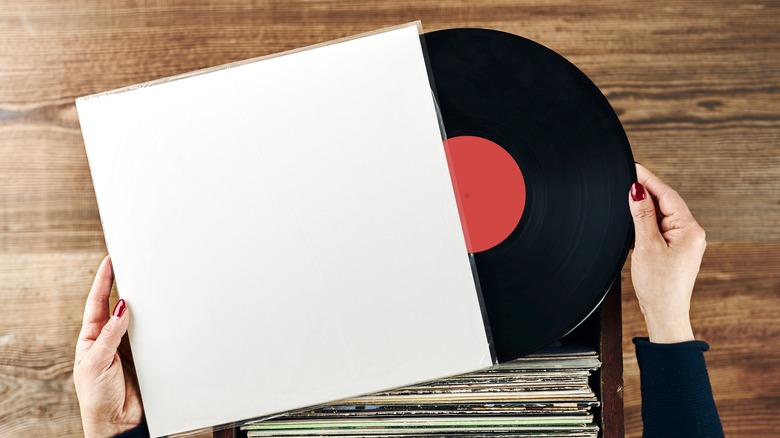12 Old Tech Devices That Are Popular Collectibles In 2023
Remember way back in 1985 when Coca-Cola decided what it really needed to dominate the soft drink market was to revamp its classic recipe? The resulting soda, colloquially called New Coke, was an almost immediate disaster. Nobody liked it, and consumers instantly demanded a return to the old formula. It's a case study in corporate failure and the perfect example of humanity's desire for the familiar.
See, part of the problem was the taste, but the bigger issue was the change to the status quo. While it's human nature to wonder if we might be happier with something new, on a long enough timescale, we're doomed to start longing for whatever we had before. It's that same mentality that keeps gaming rooms filled with vintage consoles. It's the reason CDs are still produced, even though you don't know anyone who has bought one in the last five years.
People are nothing if not nostalgic. The moment a once-popular technology becomes antiquated is the same moment it becomes a collector's item for those hoping to regain some small part of the past, rose-colored as it may be.
CRT Displays
When flatscreens first arrived on the scene, they were staggeringly expensive, the sort of thing you only saw at your rich friend's house. Slowly, however, the price came down, flatscreen TVs and monitors became more accessible, and most of us ditched our bulky CRTs in favor of the younger, slimmer models.
It was only when CRTs became an endangered species, most of them languishing in landfills or collecting dust on thrift store shelves, that we realized the mistake we had made. See, many of the classic TV shows, movies, and video games produced during the CRT era were designed with those technical specifications in mind. TV and movie scenes were shot, and video game assets were designed, to work with the limitations of CRT displays, even to take advantage of those limitations to hide flaws. When you watch those titles or play those games, and feel like they don't look as good as they used to, that isn't all in your head.
Moreover, games like Nintendo's "Duck Hunt" rely on a CRT monitor for the light gun to function. They won't work on modern displays. That's why CRT displays have become the collector's item du jour among vintage media enthusiasts.
Apple iPods
The rise of the iPod and its less popular MP3-playing competitors launched a revolution in the way people consume audio media. Suddenly, people had access to thousands (or, in the case of the early models, hundreds) of tracks, all at their fingertips. Even better, there was no need to rewind tapes or flip through bulky CD booklets to find an album. For a brief, shining moment, it felt as though we had found the way we would listen to music for the rest of time.
Then streaming happened. Services like Pandora, Spotify, and even YouTube meant that people could listen to whatever they wanted, whenever they wanted, even if they didn't own the music. The ability to jam out without needing to rip CDs or manage a library was all too tempting, and dedicated music devices like the iPod largely died out.
Looking back, there was something special about the iPod that hasn't been recaptured by any device or service, since. This is probably why classic iPods are big-ticket items on the secondary market. Ironically, the demand only got stronger when Apple discontinued the iPod and, later, the iPod Touch. These days, you can get a used iPod for about as much as you would have paid for it new. Unless, of course, you want it to actually be new in the box. If that's the case, you might have to take out a loan.
Sony Walkman
When the Sony Walkman first stepped into the Sun, it irrevocably changed the way we engage with the world. The device hit Japan in the summer of 1979 and the United States the next year, which is when we all collectively put on a pair of headphones and never took them off. The notion of taking an album with you on a walk or to the grocery store was entirely novel. Today, audio cassettes are almost as antiquated as 8-track tapes or vinyl records, which is probably why they're coming back into style.
In an increasingly digital world, there's a certain appeal to holding something hard and plastic in your hand, seeing the magnetic tape coiled inside, and snapping it into your tape player. And if you're going to listen to tapes, there's no better way to do it than with a vintage Walkman.
While the Walkman was probably destined to enjoy something of a revival eventually, the release of "Guardians of the Galaxy," with Starlord sporting his signature blue and silver TPS-L2 and the "Awesome Mix" probably didn't hurt. Fortunately for collectors, Sony made hundreds of millions of Walkmans over the last few decades and there are plenty available for about as much as you'd spend for a night at the movies. Unless you want what Starlord is rocking, that's going to cost you. Even Sony has recognized the appeal, releasing a new Walkman for the modern age.
Tamagotchi
The fall of 1996 and spring of 1997 marked the beginning of a virtual baby boom in Japan and the U.S. respectively, when a generation of kids became unsuspecting parents to a wave of digital creatures. The most well-known and most popular of these pixelated pets was the Tamagotchi — the toymakers would also release a slightly more aggressive version called Digimon, which birthed a beloved anime series of the same name — selling tens of millions of units by the end of the decade.
All of those virtual pets are surely dead by now, but that hasn't stopped collectors from digging them up to revive them. For most of us, Tamagotchi was a passing fad. At most, they are something you dig out of the junk drawer every couple of years and play with for a few hours before they return to the liminal space of forgotten toys. For others, the allure of Tamagotchi never went away and the long tail of time has provided an opportunity to scoop up rare, discontinued models.
TamaTalk, the unofficial gathering place of Tamagotchi enthusiasts the world over, is still active today, and old Tamagotchi command thousands of dollars on the secondary market. Fortunately, you can still afford one on your weekly allowance. Bandai released an updated version of the Tamagotchi for the 20th anniversary in 2017 and if the latest wave of digital pets is destined for the trash heap like their ancestors, it hasn't happened yet.
Nintendo Game Boy
The Nintendo Game Boy wasn't the first portable gaming device (there's a long list of weird and wonderful gadgets which came before) but it might as well have been. The Game Boy was so definitive that grandparents everywhere have been calling every portable gaming device a Game Boy for decades. And they'll probably keep doing it for decades yet.
Since its release in 1989, most of us have moved on to other systems. Updated versions of Nintendo's handheld devices including the Nintendo Switch, along with a host of other great devices from the Analogue Pocket to the DPD WIN 3, present plenty of handheld options. However, few have matched the feel of booting up an original Game Boy for the first time.
Today, you can get an old Game Boy on the secondary market for about $100, give or take. Although, you could spend your life savings on the games. At the time of this writing a sealed Game Boy with "Tetris" included has an asking price of $28,000. A used copy of" Pokemon Red" (no system) is up for sale for $16,999.99, or best offer. That's a lot for a system that doesn't even have a backlight, but it might be worth it.
PlayStation Portable (PSP)
Many companies have attempted to knock Nintendo off of the handheld gaming throne and none have succeeded. For a brief moment in 2005, however, it looked as though Sony might have found a way to pull it off with its first handheld device, the PlayStation Portable, otherwise known as the PSP.
Not only was the PSP an attractive and comfortable device, it still looks good nearly two decades on. Moreover, it felt like an elevated gaming experience in a way Nintendo's devices rarely do, like the handheld your dad would play while you sat next to him playing "Zelda" on the sofa. The system was also capable of playing movies and television shows on the same Universal Media Discs (UMDs) used for games. You could play "Burnout" with your buddies, then watch the best of "Beavis and Butthead" by switching the disk. Having your games and your movies on the same device was still a pretty novel idea back in 2005.
The last release for the PSP in North America occurred in 2010, with the last release worldwide happening four years later. Despite the PSP being essentially a dead technology, it has remained popular among collectors, in part because it is easily modded. If you've got 30 minutes to kill and are capable of a Google search, you can have your old PSP playing retro games and reading full-color comics before lunch.
Arcade cabinets
Modern gamers are often criticized for their commitment to what is sometimes regarded as a solitary activity. You know the stereotype; gamers hunker in basements living off junk food, their skin slowly growing more and more translucent from lack of sunlight. It's a compelling image, even if it couldn't be further from the truth for most folks who pick up a paddle.
There was a time, however, when no one could claim that a love of video games made you antisocial. Quite to the contrary, in the early days of video games, it was a necessarily social pastime. See, once upon a time the only real way you could play your favorite games was by plunking down one quarter after another at the local arcade. A generation of kids learned the thrill of victory and the sting of defeat, twenty-five cents at a time. Those days are mostly over — arcades today are sparse and overpriced — which is why collectors are snatching up vintage arcade cabinets in an attempt to recreate a small piece of those halcyon days at home.
Sensing the demand, Arcade1Up started producing newly built retro cabinets. You can pick one up at many major retailers or online, often with more than one game in a single cabinet. They're affordable, as arcade cabinets go, but don't have 30 years' worth of sweat and nacho cheese sauce soaked into them. If you want the real thing, warts and all, you better start saving your quarters.
Chunky classic keyboards
In the '70s and '80s, IBM developed a new kind of keyboard for its burgeoning computers and itshould have just stopped there, because they were the best. When a key is pressed, a spring inside the key bends and buckles, which is why they became known as buckling spring keyboards. At the moment of buckling, a lever inside the key pivots to hit a contact, registering the keypress and creating an incredibly satisfying clack.
The tactile and auditory sensation provided by IBM's Model M buckling spring keyboard made them popular among the slim crowd of computer users at the time. Their success among consumers also inspired the rise of mechanical keyboards that are still popular today.
These days, buckling spring keyboards have all but disappeared from off-the-shelf computers, in favor of slimmer and quieter keyboard technology alternatives. Some folks who have been using computers for more than a couple of decades are starting to miss them. As a result, buckling spring keyboards and other mechanical keyboards are making a comeback. You can get a used Model M on the secondary market for as little as $50 or as much as a few hundred dollars, depending on its quality and the moxie of the seller.
Vinyl records (and record players)
We can't talk about inexplicably popular antiquated tech without at least mentioning vinyl records. While other at-home music options existed prior to vinyl (music boxes, piano rolls, and phonographs provided limited background music) the vinyl record was the first to bring at-home music to the masses.
Despite being usurped several times over by the likes of 8-track tapes, cassette tapes, compact discs, digital downloads, and streaming, vinyl has managed to maintain a toe-hold in the market, even winning back some of its previously lost market share. It isn't wholly clear why vinyl records are so appealing when the convenience of free music streaming is right there. Probably, there's a certain amount of pushback, whether it's conscious or not, toward digitizing everything. Sometimes you just want to hold an album in your hand.
Based on data from 2022, streaming brought in the lion's share of revenue but physical media came in a distant second at approximately 11% of sales. Among physical sales, vinyl is overwhelmingly the most popular option. In 2022, records outsold CDs for the first time in 35 years, racking up 41 million vinyl sales compared to 33 million CDs. When we buy physical media, we want it massive, unwieldy, inconvenient, and absolutely drenched in nostalgia.
Polaroid cameras
Much like music, photography has also seen a cultural recoil against digital transformation. While the vast majority of photos snapped on any given day are digital, thanks in large part to smartphone cameras, there is a growing movement drifting back toward physical photography.
While we want to sometimes hold our photos in our hand, we've grown too accustomed to the instant satisfaction of a smartphone selfie. With that in mind, most physical photo enthusiasts have leaned into instant cameras like Fujifilm's INSTAX line or the revived lineup of Polaroid cameras. However, if you really want to take photos like you're living in a pre-internet world, you need a vintage Polaroid.
Fortunately, the original incarnation of the company pumped out an impressive range of models before it shuttered its doors for the last time. Many of them are floating around intact on the secondary market, just waiting for you to slide in a fresh set of film and click the shutter. It's also a relatively easy collection to get started, considering that vintage Polaroids are available for as little as a few dollars and as much as a few hundred or a few thousand. With a little commitment and a moderate budget, you could build a bigger instant camera collection than you can shake a Polaroid at.
Typewriters
Mechanical keyboards may be the vintage typing device of choice if you still want to use a computer, but some collectors want to ditch electricity altogether in favor of a vintage typewriter. With any luck, you can get one for free by snooping through your grandparents' attic.
Typewriters offer an offline way to compose notes, letters, documents, or stories without any of the distractions of modern computers. Of course, you'll also sacrifice a certain amount of convenience. Once you've drafted your document, it can be complicated to get it into a digital format if needed. Text scanning software is improving, but still has a ways to go. The upside is you'll be in good company — everyone's Hollywood dad, Tom Hanks, is a serious collector of typewriters, even having published an anthology of short stories, each written on a different machine.
Even absent the convenience of computers, there's a certain allure to using a dedicated machine, being unable to do anything other than put one character after another until you reach "the end." If you want to try your hand at writing on a typewriter, you can find one for under $100 and ribbons are easy to come by online. You could also spend a ludicrous amount on the right typewriter, but you might need Tom Hanks' money.
VHS tapes
Unlike vinyl, which some enthusiasts claim has a superior sound quality to digital, no one is claiming that VHS tapes are the best way to watch a movie. In fact, looking back, VHS tapes were awful. You had to rewind them every time you finished watching, which took way too long unless you had a separate dedicated tape rewinder or you felt like being a jerk to the clerk at Blockbuster. The machine would chew them up sometimes, ruining your favorite movies, and they took up way too much shelf space, especially the puffy plastic cases favored by Disney. And yet, people are willing to drop the price of a car on the right tape.
Maybe it's just that they feel like childhood, and maybe there's something special about the tracking slipping and having to watch trailers for movies that came out decades ago before your movie starts. More than that, seeing the tape coiled up inside the casing and knowing that each frame physically exists there makes it feel like you own the movie in a way DVDs and digital never could. Anyone can watch "Jurassic Park" online, but only you can watch your "Jurassic Park" VHS tape, a copy of which sold on eBay for $420.00 in July 2023.
If you happen to have popular VHS movies still sealed in the box, you might be able to make a small fortune from the right collector.












